How to Grow Turnips in Your Garden, Plus Tips for Planting and Harvesting
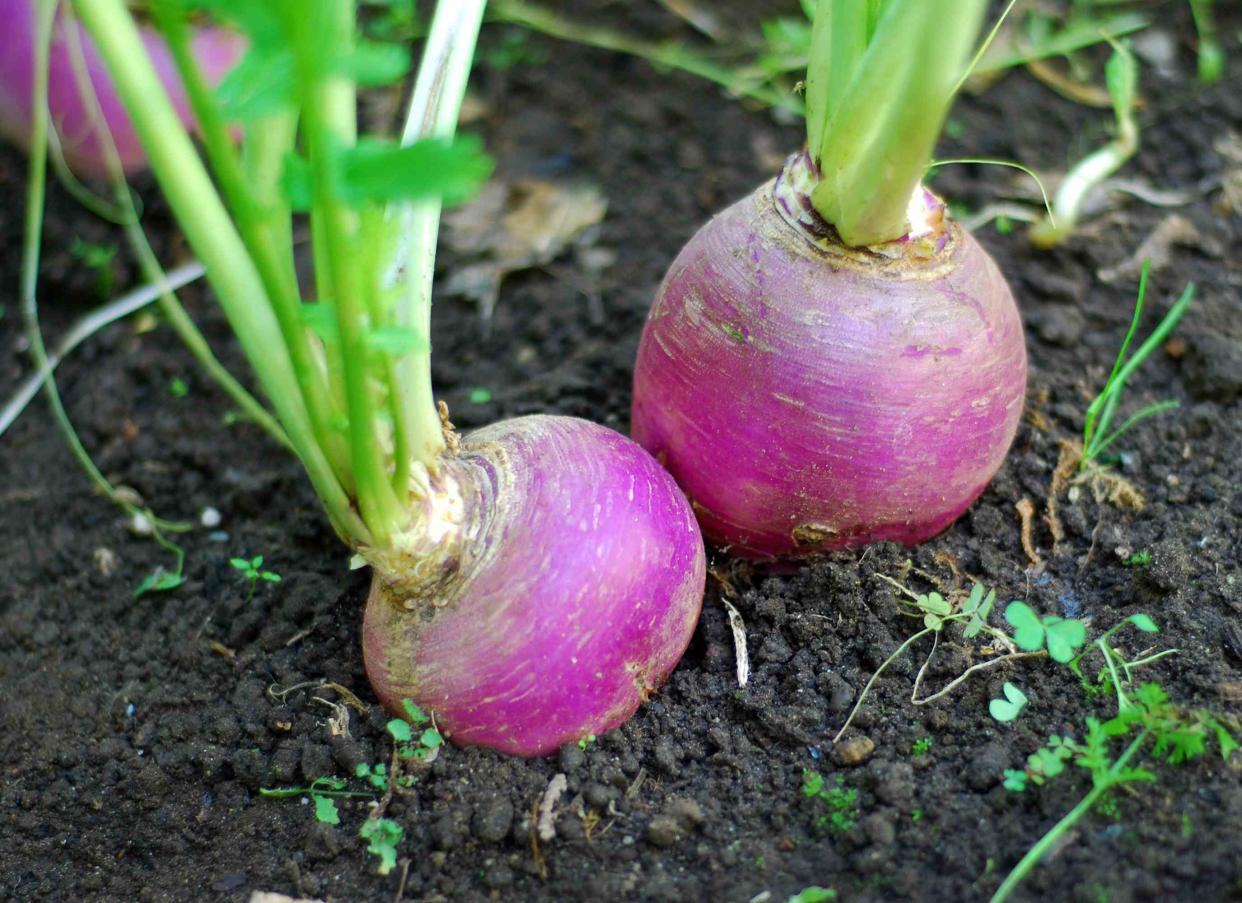
Getty Images / AnthonyRosenberg
Turnips are an easy-to-grow cool-season vegetable that produces a crop of cold-hardy, edible greens and a root that can be eaten raw, cooked, or pickled. Turnips are a form of Brassica rapa, the same species as bok choy and Chinese cabbage.
Depending on your USDA hardiness zone, plant seeds in late winter/early spring for a spring crop or in the late summer for a fall/winter crop. Select a site with loose, well-draining soil where other crops in the Brassica family have not been grown in the past three years.
6 Plant Tips for Beginners
Turnips are a cool-season crop that will not tolerate the high temperatures of summer.
Plant in an area where you have not grown cabbage, cauliflower, broccoli, Brussels sprouts, collards, kale, mustard, or rutabaga for the past three years to prevent disease.
Plant seeds one to two inches apart in rows 18 to 30 inches apart.
After germination, thin turnip seedlings leaving three to six inches between plants.
The plants need at least one inch of water per week or the root can become bitter or woody.
Harvest turnips when they reach a usable size, two to three inches wide.
Common Name | Turnip |
Botanical Name | Brassica rapa |
Family | Brassicaceae |
Plant Type | Vegetable |
Size | 2 to 3-inch root, 1-foot foliage height; 6 to 12-inch spread |
Sun Exposure | Full sun |
Soil Type | Loamy, organic |
Soil pH | Neutral to acidic |
Hardiness Zone | 2a - 11b |
Native Area | Europe |
How to Plant Turnips
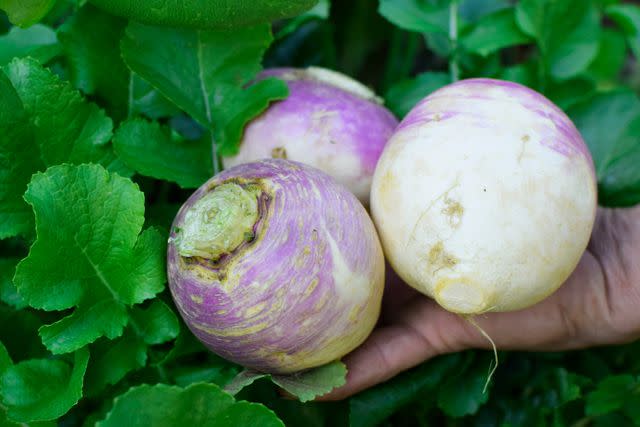
The Spruce / Randi Rhoades
When to Plant
Turnip seed should be direct sown into the garden. They can be planted in late winter/early spring or late summer/early fall. Seeds germinate quickly and mature in about eight weeks.
Selecting a Planting Site
Turnips should not be planted in an area where other Brassica crops (cabbage, cauliflower, broccoli, Brussels sprouts, collards, kale, mustard, or rutabaga) have been grown in the past three years to help prevent disease. The area should receive full sun. The soil should be tilled until it is loamy to help root growth and prevent waterlogged roots.
Spacing
Seeds should be sown one to two inches apart in rows 18 to 30 inches apart. Once true leaves have emerged, thin the seedlings to a spacing of three to six inches to allow room for root development.
Want more gardening tips? Sign up for our free gardening newsletter for our best-growing tips, troubleshooting hacks, and more!
Turnip Plant Care
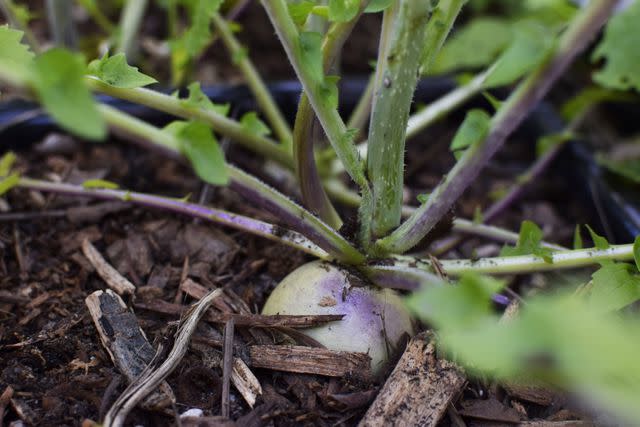
The Spruce / Randi Rhoades
Light
Turnips require full sun (at least 6 hours) to properly develop.
Soil
The soil should be loamy with a neutral to slightly acidic pH. Loose, well-draining, organically rich soil allows the turnip roots to expand and grow easily.
Water
The plants need to receive one inch of water per week from rainfall or irrigation or the root will be tough and woody. However, turnip roots do not like to be waterlogged so the soil must drain well.
Temperature and Humidity
Turnips thrive in cooler temperatures and their quality can be poor when they grow in hot weather, or if they grow too large too quickly.
Fertilizer
Since turnips thrive in slightly acidic to slightly basic soil with pH levels 6 to 7.5, have your soil tested before planting. Improve your soil by adding well-rotted manure or compost in spring or fall. Turnips do not need more fertilizer than the initial pre-planting application of compost.
Types of Turnips
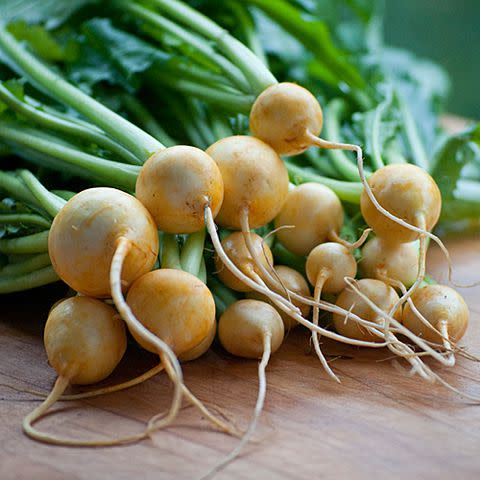
The Spruce / Marie Iannotti
‘Just Right’: Hybrid. Cold tolerant produce flavorful greens and smooth, white, slightly flattened globe-shaped roots.
‘Purple Top White Globe’: Plants produce 4- to 5-inch, nearly round, white-fleshed roots with purple shoulders. Young leaves can be cooked as greens. Also known as 'Purple-Top Globe'.
‘Yellow Globe’: Large turnip with unusually mild, crisp, cream-colored flesh.
'White Lady': Hybrid. Dark green, 20-inch plants produce pure white, semi-round, 2 1/2-inch roots. Bolt tolerant.
'Red Round': Tennis ball-sized roots with bright-red exterior and white flesh with a bit of rose blushing.
'Topper': Grown exclusively for greens. Erect plants produce dark green leaves.
'White Egg': Egg-shaped roots with snowy white flesh. Grows rapidly half out of the ground. Flavor intensifies in storage.
Harvesting
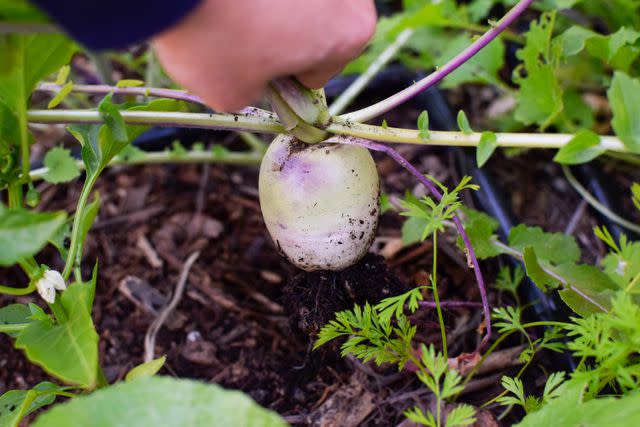
The Spruce / Randi Rhoades
Most turnip varieties will have the best flavor and texture if they are harvested while they are small, just two to three inches in width. Since turnip shoulders are usually above the soil line it is easy to see their size.
To harvest the turnip roots, use a spade to loosen the soil next to the plant. You can then pull the root from the soil. Once harvested, the greens can be cut about one inch from the root, washed, and eaten.
Harvesting Tip
The turnip roots should be washed and stored in the produce drawer of the refrigerator for up to two weeks. Because turnips lose moisture rapidly, they cannot be stored long-term.
How to Grow Turnips in Pots
If you want to grow turnips in pots, select a container that is at least 16 inches wide and at least eight inches deep with drainage holes. Fill the container with potting soil that has been amended with organic matter and water well.
Scatter the seeds and cover with about one inch of soil. Once the seeds germinate, thin the plants to about four inches apart so the roots have room to develop. Place the container in full sun, water regularly, and harvest the turnips when the roots are about two inches wide at the shoulder.
How to Grow Turnips from Seed
Turnips should be direct sowed into garden soil or containers. As a root vegetable, they do not transplant well. The seeds will germinate quickly and emerge after about 10 days. Once the true leaves have emerged, thin the seedlings to allow room for root development.
Common Pests and Plant Diseases
Many of the pests and plant diseases that cause harm to other brassica crops will also damage turnips. Flea beetles chew holes in the turnip greens, especially new leaves, but don't harm the root. Cabbage maggots, however, will feed on the roots and even tunnel through the turnip.
Turnips are vulnerable to black rot, which causes yellow triangles on the edge of the leaves, and can lead to rot and clubroot that causes roots to become stunted and small.
Frequently Asked Questions
Are turnips easy to grow?
Turnips are very easy to grow from seed. Provide full sun, an inch of water per week, and space for the roots to form.
How long does it take turnips to grow?
Turnips should be started from seed and reach maturity within eight weeks.
Do turnips come back every year?
Turnips are an annual vegetable that should be planted and grown during cooler weather of early spring and late fall. They do not come back and each seed produces one turnip.
Read the original article on The Spruce.

